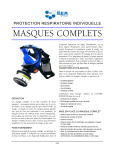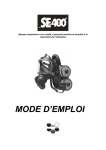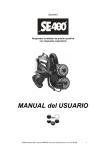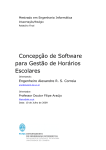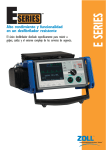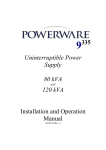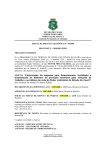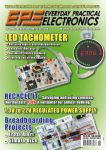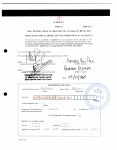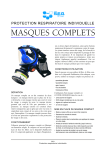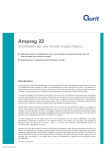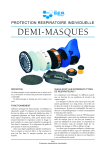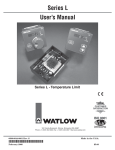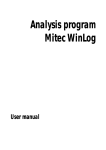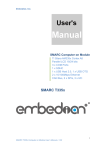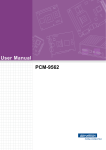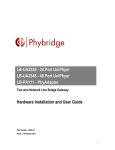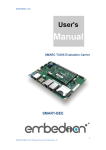Download User Instructions - the S.E.A. Group
Transcript
SE400 user instructions — 600006 M Fan-supplied Positive-pressure Breath-responsive Respirator User Instructions 600006 M May2018 Copyright © 2018 by The S.E.A. Group 1 SE400 user instructions — 600006 M TABLE OF CONTENTS ABOUT THESE USER INSTRUCTIONS .................................................................................. 3 DESCRIPTION OF THE SE400 ................................................................................................ 4 Main components .................................................................................................................. 5 Features ................................................................................................................................ 5 CAUTIONS AND LIMITATIONS ............................................................................................... 6 UNPACKING ............................................................................................................................. 7 FACEPIECE FITTING ............................................................................................................... 8 QNFT Procedure ................................................................................................................... 8 PREPARATION FOR USE ..................................................................................................... 10 Assembling the SE400 ........................................................................................................ 10 Donning the SE400 ............................................................................................................. 10 WORKING IN A CONTAMINATED AREA ............................................................................. 14 Decontamination ................................................................................................................. 14 STORAGE AND TRANSPORT ............................................................................................... 15 COMPONENTS OF THE SE400 ............................................................................................. 16 Fan unit................................................................................................................................ 16 Breathing hose .................................................................................................................... 16 SE-shield breathing hose .................................................................................................... 16 Facepiece ............................................................................................................................ 16 Filtration media .................................................................................................................... 17 Batteries .............................................................................................................................. 19 Battery charger (BC3) ......................................................................................................... 22 Battery charger (BC1) ......................................................................................................... 22 Dual battery adapter (DB1) ................................................................................................. 23 SE-talk speaker unit ............................................................................................................ 23 Back pack ............................................................................................................................ 24 Waist belt ............................................................................................................................. 24 SE-SHIELD PROTECTIVE ENSEMBLES .............................................................................. 25 Configurations ..................................................................................................................... 25 The SE-Shield range ........................................................................................................... 25 OPERATION ........................................................................................................................... 27 Visible and audible warnings ............................................................................................... 27 Warnings label on fan unit ................................................................................................... 27 Warnings during start-up ..................................................................................................... 28 Warnings during operation .................................................................................................. 29 Stand-by mode .................................................................................................................... 29 Demist mode ....................................................................................................................... 30 Menu mode ......................................................................................................................... 30 Self-Test .............................................................................................................................. 30 DISASSEMBLY AND REASSEMBLY .................................................................................... 32 CLEANING AND MAINTENANCE ......................................................................................... 35 Reconditioning after each use ............................................................................................. 35 Cleaning the demand valve ................................................................................................. 35 Replacing the visor (full facepiece) ..................................................................................... 38 SPARE PARTS AND ACCESSORIES ................................................................................... 39 TROUBLESHOOTING ............................................................................................................ 40 OPERATION IN EXTREME CONDITIONS............................................................................. 41 SE-DATA ................................................................................................................................. 41 IMPORTANT WARRANTY INFORMATION ........................................................................... 41 IN CASE OF HEAVY IMPACT ................................................................................................ 41 APPROVAL BODIES .............................................................................................................. 42 Copyright © 2018 by The S.E.A. Group 2 SE400 user instructions — 600006 M Warning (USA) Before occupational use of this respirator a written respiratory protection program must be implemented meeting all the local government requirements. In the United States employers must comply with OSHA 29 CFR 1910.134 which includes medical evaluation, training, and fit testing. ABOUT THESE USER INSTRUCTIONS These user instructions refer to the following user instructions for components and accessories of the SE400: Supplementary manual – SE400 advanced functions (600007) SE-shield Tychem F© suits (100184-04) SE-shield Tyvek© and Tychem QC© suits (100325-03) SE-shield encapsulated suits (100292-02) Tychem F© Hood (100259-04) Breathing hose cover HC-TF (100257-03) Foam insert SEA-FI (100287-03) GBCO (600010) Fit test adapter FTA-400 (100288-03) Back pack BP2 (100267-03) Exhalation valve shield EVS (201540-03) Dual battery adapter DB1 (100273-03) The above user instructions are supplied with the components. They are also available at The S.E.A. Group website, www.theseagroup.com Copyright © 2018 by The S.E.A. Group 3 SE400 user instructions — 600006 M DESCRIPTION OF THE SE400 The SE400 is a powered air-purifying respirator (PAPR) designed to give protection from breathing hazards. It is a high-performance PAPR known as an FPBR (Fan-supplied Positivepressure Breath-responsive Respirator). The SE400 has a built-in microprocessor that monitors the user’s breathing pattern and adjusts the airflow to ensure continuous positive pressure in the facepiece even during high exertion. Because the SE400 delivers breathing air only when needed, battery power and filtration media capacity are conserved. Positive pressure Positive pressure increases breathing protection. An airtight “face seal” – between the facepiece and the user’s face – is critical for good respiratory protection. In practice it is very difficult to maintain a perfectly airtight face seal under all conditions. Even momentary loss of sealing can greatly reduce the level of protection. By maintaining a slightly elevated air pressure inside the facepiece at all times, any leakage will flow outward, thus preventing inward leakage of contaminated air to the breathing zone. A conventional PAPR delivers an essentially constant flow of breathing air to the facepiece. During high exertion the user may take very deep breaths that momentarily exceed the delivery rate of the PAPR. At these times the facepiece pressure becomes negative and inward leakage of contaminants can occur. Because the SE400 “FPBR” is breath-responsive, continuous positive pressure can be maintained at peak inhalation airflows up to and exceeding 350 litres per minute. Positive pressure reduces breathing resistance. Because the air in the breathing zone is maintained at a very small positive pressure, the user feels little or no breathing resistance. By reducing the breathing effort and discomfort, he or she has more energy and awareness to do the job at hand. The SE400 is currently available in the following models: SE400AT-2 – Two-filter fan unit for industrial applications SE400AT-2 Advanced – Two-filter industrial unit with advanced functionality SE46 – Three-filter fan unit for emergency response applications – includes increased peak flows, battery duration, gas filter capacity and chemical resistance; Advanced functionality; Normally fitted with Exhalation Valve Shield (EVS) and single-use Tychem F® hose cover (HC-TF) Note: SE400AT-2 Advanced and SE46 users should consult the supplementary manual “SE400 Advanced Functions” on the CD-ROM provided with those models. Note (USA): SE400 and SE46 respirators are approved by NIOSH for use in industrial environments. They are not CBRN-approved. Note: The SE400AT-2 supersedes the SE400AT. SE-Talk speaker unit and PC data cable are not interchangeable between these models. Copyright © 2018 by The S.E.A. Group 4 SE400 user instructions — 600006 M Main components A comprehensive list of components is given in section Components of the SE400. 1. 2. 3. 4. 5. 6. 7. 8. 9. Fan unit (SE400AT-2 shown) Filtration media Breathing hose Facepiece Demand valve Battery SE-Talk speaker unit Back pack Prefilters and prefilter holders Features 1. ON/OFF button 2. Status lights panel 3. Communication socket 4. Threaded connectors for filtration media 5. Threaded nuts for attachment to SE-shield protective suits 6. Warning light Copyright © 2018 by The S.E.A. Group 5 SE400 user instructions — 600006 M CAUTIONS AND LIMITATIONS When using this respirator, observe the following cautions and limitations. Oxygen levels Not for use in atmospheres containing less than 19.5% oxygen. This respirator delivers purified ambient air. It does not generate oxygen. Breathing hazards Not for use in atmospheres immediately dangerous to life and health (IDLH) or where hazards have not been fully characterised. Do not exceed maximum use concentrations established by regulatory standards. If you sense any of the following danger signals: o smell or taste of contaminants o eye, nose or throat irritation o breathing difficulty o uncomfortably warm breathing air o dizziness, nausea or vomiting, immediately leave the contaminated area. Do not remove the respirator until you have reached clean air and after decontamination as required. Explosive atmospheres Contains electrical parts which may cause an ignition in flammable or explosive atmospheres. Do not use in flammable or explosive atmospheres. Exposure to flame Do not use in contact with flame. Do not use for fire fighting. Dermal (skin) hazards Use in conjunction with personal protective ensembles that provide appropriate levels of protection against dermal hazard. Failure to do so may result in personal injury even when the respirator is properly fitted, used and maintained. Follow these User Instructions Failure to properly use and maintain this respirator could result in injury or death. Follow these user instructions and established canister change-out schedules to ensure canisters are replaced before breakthrough occurs. Never substitute, modify, add or omit parts. Use only exact replacement parts in the configuration as specified by the manufacturer. Compliance with regulations (USA) All approved respirators shall be selected, fitted, used and maintained in accordance with MSHA, OSHA and other applicable regulations. Use replacement parts in the configuration as specified by the applicable regulations and guidance. Consult the respirator Approval Label (USA) for approved configurations. Copyright © 2018 by The S.E.A. Group 6 SE400 user instructions — 600006 M S - Special or Critical User's Instructions (USA) Foam Inserts If Facepiece Fit Testing fails due to particular facial contours, SEA recommends that the SEA Full Face Mask Foam Insert (model number SEA-FI) be inserted into the facepiece. Please refer to the User Instructions for the foam inserts or contact an SEA Group representative for more information. Note: NIOSH has classified the foam inserts as a required component. However, foam inserts shall only be used in cases where a satisfactory facepiece fit cannot be achieved without them. UNPACKING The following parts are included with the SE400: Fan unit Breathing hose and hose latch retainer Facepiece with demand valve and head harness Waist belt Prefilters and prefilter holders SE400 user instructions Cleaning tissues Up to two (2) batteries (level of charge not assured) Battery charger with power supply and AC power cable Speaker unit CD-ROM containing user instructions and management software (Advanced only) Data cable for connection to PC (Advanced only) NIOSH Approval Label (USA) Single-use breathing hose cover (SE46 only) Exhalation valves shield (SE46 only) Check that all components are received as ordered, and undamaged. Copyright © 2018 by The S.E.A. Group 7 SE400 user instructions — 600006 M FACEPIECE FITTING Note: This section applies to full facepiece respirators only. The SE400 is designed to maintain positive pressure inside the facepiece even under conditions of high workload and stress. However, a quality face seal is essential for optimum protection. This is particularly important in the event that the blower unit stops operating and the SE400 must function as a negative pressure respirator. A user must pass a Quantitative Fit Test (QNFT) and achieve a fit factor of at least 2000 before being assigned a full facepiece respirator. This is a negative pressure test; i.e.: with the fan unit disconnected or not operating. Quantitative Fit Test A Quantitative Fit Test (QNFT) gives a numerical measure of facepiece fit. The user wears a respirator in a test atmosphere while an instrument compares the concentration of the challenge agent in the test atmosphere with that inside the facepiece. The test atmosphere may be air contaminated with an aerosol, vapour or gas. With some instruments ambient air can be used. The QNFT protocol must be in accordance with appropriate government regulations. Facepiece fit testing has a number of aims: 1. To assess the suitability of the respirator for each person for use in real situations. Due to natural variations in human facial features, no one size or style of full facepiece can be guaranteed to fit everyone. A QNFT, properly conducted, can be used to determine if the respirator is suitable for each user. 2. If the respirator is found to be unsuitable, to determine if the same respirator fitted with the Full Face Mask Insert (SEA-FI) is suitable. The Full Face Mask Insert is an adhesive-backed foam strip, inserted behind the face seal, intended to accommodate unusual facial features or small faces. Once again, a QNFT must be performed to determine if this configuration is suitable for each user. 3. To train each user in the correct donning technique that will ensure a good facial fit during future use. It is extremely important that the donning technique learned by each user during the QNFT is employed in all future use, where fit testing will not normally be available. In particular, the head harness tension used to pass the QNFT should be appropriate for extended use in real situations; if excessive harness tension is needed to pass, the respirator should be considered unsuitable, and should not be used by that person. QNFT Procedure The recommended method for performing the QNFT is with the S.E.A. Fit Test Adapter (FTA-400). Alternatively, a modified test facepiece may be used. Both methods are described below. Copyright © 2018 by The S.E.A. Group 8 SE400 user instructions — 600006 M To prepare for a QNFT using the Fit Test Adapter FTA-400: 1. Detach the breathing hose from the SE400 facepiece 2. Attach the FTA-400 to the facepiece in place of the breathing hose and attach a HE/P100 particulate filter, following the user instructions provided with the FTA400. The SE400 facepiece is now configured as a negative pressure respirator. The SE400 fan unit is not required for this test 3. Check that the facepiece, demand valve and FTA-400 are complete and correctly assembled 4. Don the respirator in accordance with section Donning the SE400 step 2, steps 4 through 8 and step 12 To prepare for a QNFT using a test facepiece: 1. Detach the breathing hose from the SE400 facepiece 2. Attach to the breathing hose a modified SE400 test facepiece containing a sampling port connecting to the breathing zone of the facepiece. The test facepiece should be leak tested by a suitable method prior to use. 3. Fully assemble the SE400, including filters. The SE400 can now be tested, with the blower off, as a negative pressure respirator 4. Don the respirator in accordance with section Donning the SE400 steps 1 through 8 and steps 12 and 15 To perform a QNFT: 1. Prepare and don the respirator using one of the methods described above 2. An assistant should inspect the fit of the respirator. Check for significant gaps between the rim of the facepiece and the user’s face. If significant gaps are visible, consider fitting the Full Face Mask Insert (SEA-FI). Doff the facepiece, fit the Insert in accordance with its user instructions, and don the facepiece as before. 3. Enter the test atmosphere (if required) and connect the test instrument’s sampling tube to the sampling port on the FTA-400 or test facepiece 4. Perform an appropriate QNFT exercise sequence and determine the fit factor i. If the fit factor is 2000 or greater, the respirator should be considered suitable for the user. No further testing is required ii. If the fit factor is less than 2000, an observer should check that the respirator is correctly assembled, and properly fitted in accordance with section Donning the SE400 step 12. The user should check head harness tension and adjust if necessary. Go to step 5 below iii. If during step ii above the observer detects fitting problems which cannot be overcome by adjustment – in particular, visible gaps between sealing rim and the user’s face – the Full Face Mask Insert (SEA-FI) may provide a solution. Doff the facepiece, fit the Insert in accordance with its user instructions, and don the facepiece as before. Go to step 5 below 5. Repeat the QNFT and determine the fit factor o If the fit factor is 2000 or greater, the respirator in the configuration tested – with or without Insert as appropriate – should be considered suitable for the user. No further testing is required o If the fit factor is again less than 2000 the respirator should be considered unsuitable and should not be used by that person Note: Some “trial and error” is acceptable when carrying out facepiece fit testing. Sound judgement by experienced personnel is essential when assessing the suitability or otherwise of a respirator. Remember that the donning and adjustment method used during testing must be appropriate for subsequent use in real situations. Copyright © 2018 by The S.E.A. Group 9 SE400 user instructions — 600006 M PREPARATION FOR USE Assembling the SE400 Before use, check that the SE400 is fully assembled. To assemble, consult the relevant section of the user instructions, as noted below. Breathing hose connection to fan unit – consult section Disassembly and reassembly Breathing hose connection to facepiece – consult section Disassembly and reassembly SE-talk speaker unit – consult section Disassembly and reassembly Battery – consult section Batteries Harness: o Standard waist belt – consult section Waist belt o Back pack – consult user instructions supplied with the back pack Dual battery adapter (if required) – consult user instructions supplied with the adapter Filtration media – consult section Filtration media Donning the SE400 The user must be familiar with and practise the donning and doffing procedures prior to respirator use. Warning Men should be clean-shaven, and should not have facial hair such as beards or large sideburns. Facial hair can seriously compromise the face seal and result in reduced protection. Note: Before donning a respirator for the first time, perform a facepiece fit test per section Facepiece Fitting (applies to full facepieces only). SEA recommends that each new (unused) respirator be tested for facepiece fit even if the user is experienced with the respirator. Note: Users who have been approved to use the SE400 only with Full Face Mask Insert (SEAFI) should check that the insert is correctly fitted and is in good condition prior to donning. Note: Before first use and after maintenance, perform a respirator “Self-Test”. Refer section Operation. Note: Users should be well hydrated before donning and using the respirator. Note: When donning the SE400 with an SE-shield protective suit, consult the SE-shield user instructions. Procedure: 1. Visually inspect the respirator for completeness, correct assembly and lack of damage 2. Put the facepiece neck strap over your neck 3. Put on the fan unit (with back pack or waist belt) and adjust the straps 4. Fully loosen the head harness straps 5. Clear all hair away from your face. A thin elasticised head band may be used, provided it is kept clear of the face seal Copyright © 2018 by The S.E.A. Group 10 SE400 user instructions — 600006 M For full facepiece only: 6. Holding the facepiece in one hand and the head harness in the other, place your chin in the cup of the facepiece 7. Pull the head harness over and down the back of your head and stroke it down. Clear any hair away from the face seal 8. Tighten the head harness straps in pairs by pulling the free ends backwards. Start with the neck straps, followed by the temple straps and finally the forehead strap For half facepiece only: 9. Don the half mask so that the harness pad rests on the crown of the head 10. Release the snap-catch at the back of the head, adjust the harness tension, and lock the snap-catch Copyright © 2018 by The S.E.A. Group 11 SE400 user instructions — 600006 M For standard waist belt only: 11. Position the fan unit on the either side of the body as desired. Adjust the breathing hose swivel to position the hose. Mount the SE-Talk on the breast pocket, or on the belt (shown) using the SE-Talk belt attachment HSE CAUTION: The fan unit should always be worn with the filtration media facing downwards or to one side, but never facing upwards. For all configurations: 12. Check that the face seal touches the skin all around, especially under the chin cup and at the temples. Try moving the mask to verify that there is no slippage. The straps should be tightened firmly enough to prevent movement on the face during use, but should not be overly tight. Excessive tightness may lead to increasing discomfort during use. Check once again that there is no hair under the face seal 13. Turn on the fan unit by pressing and releasing the button on the speaker unit. Alternatively, press and release the ON/OFF button on the fan unit 14. Perform a User Seal Check * by pressing and holding the SE-Talk button for more than three seconds, causing the SE400 to run at full fan speed (“Demist mode”). You should not feel any air leakage around the face seal. After 20 seconds the SE400 automatically returns to normal operating mode. If any leakage is evident, correct immediately by re-stroking the head harness to the back and retighten neck, temple and forehead straps. The straps should be tightened firmly enough to prevent movement on the face during use, but should not be overly tight. Excessive tightness may lead to increasing discomfort during use. Check once again that there is no hair under the face seal 15. Rotate your head and check for comfortable, free movement. Adjust hose swivel at mask end as required. 16. Adjust the level of the speaker unit whilst speaking Copyright © 2018 by The S.E.A. Group 12 SE400 user instructions — 600006 M 17. Check the warning light in front of the mask. It should not be lit. The audible alarm should be silent. If not, investigate. Do not enter a contaminated area until it is resolved 18. Don any outer protective clothing as required. You are now ready to enter a contaminated area. * Note: The User Seal Check is a simple check for gross leakage prior to use. It is not a substitute for a quantitative fit test (QNFT). Buddy Check When entering a contaminated area in groups of two or more, it is good practice to perform a “buddy check”. Pairs of users should visually inspect – but should not adjust – each other’s respirators, checking for things like correct mask positioning, strap tightness, absence of hair in the face seal, correct fitment of battery, hose and hose cover, filters and accessories, etc. Check that the fan unit is operating correctly by observing the status lights panel on the fan unit (refer to section Operation for further details). Warning If the facepiece has been properly donned and adjusted, detection of contaminant odour or taste, or irritation of eye, nose or throat during use may indicate exhaustion of the filtration media. Return to fresh air immediately without removing the respirator, check facepiece fit and replace filtration media. Used filtration media should be disposed of properly in accordance with state and/or local guidelines for disposal of contaminated material. (attach CD-ROM here) Copyright © 2018 by The S.E.A. Group 13 SE400 user instructions — 600006 M WORKING IN A CONTAMINATED AREA Before entering a contaminated environment, ensure that the SE400 is suitable for use in that environment. Consult section Cautions and Limitations. For information on the operation of the SE400, see section Operation. Try to remain relaxed at all times. Breathe normally. Do not over-exert yourself if you don’t have to. Reducing effort prolongs battery and filtration media life. Be aware of the SE400 warnings (facepiece warning light, audible alarm) In the event of a malfunction of the SE400, do not panic. Leave the contaminated area quickly but safely. Do not remove the facepiece from your face until you have reached clean air and have been decontaminated. Remember that even without the blower operating the SE400 continues to function as a negative-pressure APR and gives considerable protection. If you sense any of the following danger signals: o smell or taste of contaminants o eye, nose or throat irritation o breathing difficulty o uncomfortably warm breathing air o dizziness, nausea or vomiting immediately leave the contaminated area. Do not remove the respirator until you have reached clean air and have been decontaminated. Be aware of the position of the breathing hose – take care to avoid catching on any objects or obstructions in the work environment Decontamination After exposure in a contaminated environment, the respirator and the user may require decontamination in order to prevent contamination of clean areas, and to prevent contamination of and injury to the user and other personnel. Decontamination procedures should be developed as part of the organisation’s respirator program and should be appropriate to the hazards involved. When developing a decontamination procedure, consider the following guidelines: The SE400 is water-resistant. It is NOT waterproof! Never submerge the SE400 in water. Leave the speaker unit connected to the fan unit. This will protect the connector terminals. Do not remove the facepiece or turn off the blower until after initial decontamination. After removing the facepiece, do not allow direct water streams inside the facepiece. Water may enter the fan unit through the breathing hose and cause serious damage. Do not use compressed air when cleaning. The SE400 contains sensors for measuring facepiece pressure and ambient pressure that may be damaged. Filtration media should always be discarded after decontamination in a shower. Batteries can be decontaminated in a water shower. After doing so, shake off the water and place it on a dry surface with the contacts downwards. Batteries should be thoroughly dry before recharging. The breathing hose may be fitted with a single-use chemically resistant cover. This cover should be removed and discarded during decontamination. The breathing hose should be decontaminated after the cover has been removed. A replacement cover should be fitted ready for next use. Consult user instructions supplied with the hose cover. Copyright © 2018 by The S.E.A. Group 14 SE400 user instructions — 600006 M Do not disconnect the breathing hose from the facepiece or fan unit during decontamination. If disconnected, water may enter and damage the respirator. Note: Before decontaminating with a high pressure shower, it is advisable to remove the prefilters, which may become waterlogged and block the airflow. Note: All disposable contaminated material – such as filtration media, prefilters and breathing hose covers – should be disposed of in accordance with state and local guidelines for hazardous waste materials. After decontamination, the SE400 should be prepared for reuse. This normally involves: thorough cleaning of external surfaces. Do not use solvents on the SE400 visual inspection for condition and completeness replacement or repair of components as required recharging of battery(s) performing a Self-Test ensuring all parts are dry before storage STORAGE AND TRANSPORT The SE400 is designed to withstand harsh working conditions and inhospitable environments. However, proper storage and transport methods will prolong the life of the respirator and ensure it is always capable of optimum performance. When storing or transporting the SE400, keep in mind the following points: Store in clean and dry area Store in ambient conditions between –20 and +55°C (–4 and +131°F) and less than 70% relative humidity. Battery may be stored at +55°C no longer than one month. For longer term storage, consult section Battery care and maintenance. Protect the respirator and components from potential hazards such as sharp edges, heavy weights, abrasives, chemicals and moisture Avoid sources of vibration Do not store in direct sunlight Gas filters should be stored in airtight containers at all times when not in use Warning Batteries in storage do not retain full charge indefinitely. Periodic recharging is necessary to maintain full charge. Consult section Batteries for more information on charging and maintaining batteries. Copyright © 2018 by The S.E.A. Group 15 SE400 user instructions — 600006 M COMPONENTS OF THE SE400 Fan unit The fan unit contains a centrifugal blower for drawing purified air from the canisters and delivering it under pressure to the facepiece via the breathing hose. It is constructed from rugged ABS plastic. The fan unit has threaded connectors for attachment of filtration media. The fan unit contains electronics that control the air delivery rate. It also has many advanced functions such as warnings for filter end-of-life and filter missing, logging of important operating data and real-time monitoring of facepiece pressure. It can be connected to a PC for configuring the fan unit parameters and downloading operating data. Consult supplementary manual, SE400 advanced functions. The fan unit model number is located on the identification label on its underside. Each filter position is fitted with an external thread, gasket and nut for connection to SEshield suits. Consult the SE-shield user instructions for use. Note: The SE-shield suit-sealing nuts should remain fitted to the fan unit at all times, even when not used with a suit, in order to protect the threads from damage. Breathing hose The breathing hose conveys purified air from the fan unit to the facepiece. It also links the facepiece pressure detection, speech microphone and warning light to the fan unit. The flexible hose is made from tough polyurethane. The breathing hose should remain connected to the fan unit at all times. The breathing hose model number is located on the attachment to the fan unit, and is not visible when the hose is fitted to the fan unit. SE-shield breathing hose The SE-shield breathing hose is used in place of the standard breathing hose when the SE400 is used with SE-shield protective suits. The SE-shield breathing hose directs a small amount of filtered air from the SE400 into the suit, maintaining positive pressure inside the suit. For more information consult section SE-shield protective ensembles. Facepiece Full facepiece The full facepiece is available in a single size to fit all faces. It is available in the following materials: Silicone rubber (RF3-FS) for maximum comfort in normal industrial use Halo-butyl rubber (RF3-FP or RF3-FP-C) and chloroprene rubber (RF3-FC) for applications where high chemical resistance is required The full facepiece visor is available in the following materials: High-clarity polycarbonate (standard) Polycarbonate with hard coating for chemical and scratch resistance (standard on RF3-FP-C, optional on others) “Triplex” laminated glass for maximum chemical resistance (optional on all but RF3FP-C) The demand valve regulates the air flow to the facepiece in response to the user’s breathing requirements. It is made to S.E.A.’s patented design. Copyright © 2018 by The S.E.A. Group 16 SE400 user instructions — 600006 M The full facepiece can be identified by the markings: “RF3” on demand valve attachment inside inner mask “FS”, “FP” or “FC” on mask body above visor. “C” on corner of visor (RF3-FP-C only) Note: If a good face fit cannot be achieved for a particular user, the S.E.A. Full Face Mask Insert (SEA-FI) may be fitted to the mask to improve the fit. This should be done in conjunction with a face fit testing program. See section Facepiece Fitting. Half facepiece The SE400 half facepiece is intended for use in general industrial environments. It consists of a one-piece silicone facepiece attached to the demand valve. The half facepiece is available in three sizes: Small (RH1-S), Medium/Large (RH1-M/L) and Large (RH1-L). Demand Valve The demand valve is attached to the front of the facepiece. It should remain fitted to the facepiece at all times other than for periodic thorough cleaning or if necessary for maintenance. The demand valve model number is located on the outer surface of the housing. Filtration media HE filters (particle filters) High Efficiency (HE) filters (in USA) and particle filters Class P3 (including P1 and P2) (in other countries) protect against all types of airborne particles such as dust, oil mist, smoke, aerosols, bacteria, viruses and mould, with a separation level of more than 99.97%. Particle filters Class P4 (including P1, P2 and P3) (in countries other than USA) provide protection as per P3 filters but with a separation level of more than 99.997%. Chemical cartridges (gas filters) Chemical cartridges (in USA) and gas filters (in other countries) provide protection against gases in concentrations up to 0.5 per cent by volume or 5,000 ppm. Refer to regulatory guidelines. Prefilters Pre-filters are coarse particulate filters which prevent clogging or other contamination of the main filtration media. Pre-filters should always be fitted to clip-in filtration media, and should be replaced frequently. Copyright © 2018 by The S.E.A. Group 17 SE400 user instructions — 600006 M The SEA prefilter (221) may be used with any SEA filter. Use prefilter holder PFH-T with threaded filtration media, and prefilter holder 20062 with clip-in filtration media. Approval of filtration media Use only filtration media approved for use with the respirator. (USA) Consult the NIOSH approval label supplied with the respirator and filtration media. (Europe and Australasia) Consult the user instructions provided with the filtration media. Note (USA): SE400 respirators with half facepieces do not provide CN/CS protection. Warning Only original SEA filtration media, approved for use with the SE400, may be used. Chemical cartridges (gas filters) must never be used without HE filters (particle filters) fitted. Follow established canister change-out schedules to ensure canisters are replaced before breakthrough occurs. Incorrect fitment of filtration media may result in lost or reduced protection of the SE400 The SE400 should be fitted only with matching filtration media – each filter should have the same part number and age. To fit threaded filtration media: Note: Method for SE400AT-2 is shown. For SE46 use the same method but with three filtration media. 2 1 3 1. Check that the filtration media are of the correct type and class (if unsure, check with supervisor) 2. Check that the model number on the filtration media is correct and that the use-by date has not expired 3. When using new filtration media, check that the sealed packaging is intact and airtight 4. Remove the filtration media from the packaging 5. Check the filtration media for damage. Filtration media with visible physical damage should be discarded immediately 6. Check that the threads on the filtration media and fan unit are clean and the gaskets in the fan unit are clean, undamaged and properly seated 7. Screw each of the filtration media (1) into the fan unit and tighten firmly. Spin the filter until it begins to tighten, then turn another 120º or so (slightly more than a quarter turn). Take care not to overtighten. Note that the fan unit gasket has a selflocking design, so the turning resistance will increase steadily as it is tightened 8. Fit prefilters (2) into prefilter holders (3) and snap them on to inlet of filtration media. Copyright © 2018 by The S.E.A. Group 18 SE400 user instructions — 600006 M To fit clip-in filtration media using threaded filter adapters: 1. Fit threaded filter adapters TA1 or NR280-3 (4) to the fan unit as per steps 6 and 7 above 2. Attach the clip-in filtration media (1) to the adapters. Ensure that the arrows on the labels point towards the fan unit. Make sure that the flanges of the filtration media sit snugly into the rubber grooves in the adapters 3. Fit prefilters (2) into prefilter holders (3) and snap them on to the filtration media. To remove the filtration media: 1. Simply unscrew and remove. Batteries The SE400 is powered by one or two rechargeable Nickel Metal Hydride (NiMH) batteries. Batteries can be easily interchanged. If used and maintained correctly a battery will give a service life of up to 500 charge/discharge cycles. Single battery configuration When used in single battery configuration, the battery is fitted directly to the SE400 fan unit. Dual battery configuration The Dual Battery Adapter is used to provide dual battery configuration for the SE400, giving it extended operating time. See section Dual Battery Adapter. Battery operating time The operating time of the SE400 when fitted with fully charged battery or batteries greatly depends on the workload of the user, in the same way that a motor vehicle’s fuel consumption depends on the load, terrain and manner of driving. Prolonged periods of high exertion and/or stress will significantly reduce the operating time. In these situations the user can expect a shorter available working time in a contaminated area. NIOSH has certified the operating time of the SE400 at 4 hours minimum, in both single and dual battery configurations, under standard test conditions (38 litres per minute) when tested on a breathing machine (USA). Warning The above operating times are not guaranteed in real situations. Actual operating times may be significantly longer or shorter, depending on working conditions. Copyright © 2018 by The S.E.A. Group 19 SE400 user instructions — 600006 M Note: Operating time is affected by the following: Conditions of use. High breathing rates will result in reduced operating time. Level of charge of battery(s). Only fully charged batteries should be fitted to the SE400 before use. Battery condition. Batteries degrade over their working lives. A battery nearing the end of its life will have a reduced capacity. A battery should be replaced when the operating time has reduced significantly. Battery temperature. Towards the upper end of the operating temperature range of the SE400 battery performance diminishes only slightly. At battery temperatures below 5°C (41°F) , capacity diminishes sharply. Allow batteries to cool after charging and before use. Low battery warning The SE400 gives a series of audible and visible warnings as the end of operating time approaches. The first low-battery warning occurs at least 5 minutes before the SE400 shuts down. The warning time is independent of the operating conditions. Note: The SE400 provides full breathing performance at all times until the fan unit shuts down due to low battery level. Warning Old batteries in poor condition may cause the low battery warning time to be reduced. Battery care and maintenance Batteries in storage do not retain full charge indefinitely. Periodic recharging is recommended to maintain full charge. Never allow a battery to become fully flat whilst in storage. A fully discharged battery may suffer permanent degradation over time. Ideally, batteries should be stored in the temperature range 10 to 25°C (50 to 77°F) to minimise degradation during long-term storage. Batteries in long-term storage should be recharged at least once per year, and preferably every six months, to minimise degradation. Optimum battery condition is maintained by storing batteries in the Gang Battery Conditioner (GBCO) (not supplied with the SE400 respirator). When stored in the GBCO, batteries receive regular conditioning cycles and are maintained in ready-to-use condition, with close to full charge. Consult the user instructions provided with the GBCO. Warning If handled incorrectly, NiMH batteries can leak toxic electrolyte, and in some circumstances explosion may occur. Be sure to observe the following safety precautions: Never disassemble a battery Never short-circuit the terminals of a battery. Do not carry or store a battery with other metal objects as short-circuiting may result Never heat a battery or dispose of it by fire. Leakage and explosion may result Never leave a battery exposed to direct sunlight, or close to a source of heat, for extended periods whilst not in use Never immerse a battery in water or other liquid The battery is designed specifically for the SE400 range of respirators. Do not attempt to use it to power any other equipment. Copyright © 2018 by The S.E.A. Group 20 SE400 user instructions — 600006 M To attach the battery to the fan unit: 1. Check that the contacts on the battery and the fan unit are clean and intact 2. Withdraw the locking slide on the fan unit 3. Press the locking tongue 4. Hook the battery onto the fan unit. The two posts on the fan unit should engage with the sockets on the battery 5. Swing the battery into place and release the locking tongue 6. Push the locking slide back into place 7. Check that the battery is securely fastened To remove the battery from the fan unit: 1. Withdraw the locking slide 2. Press the locking tongue, releasing the battery 3. Push the locking slide back into place Copyright © 2018 by The S.E.A. Group 21 SE400 user instructions — 600006 M Battery charger (BC3) The Battery Charger BC3 fully charges a single battery (B1 or later) in five hours. The charging cycle consists of two phases: 1. Fast charging – battery is charged to approximately 90-95% capacity within two hours 2. “Post trickle charge” – slow charge to reach full capacity. After charging a battery the charger switches off automatically. Removing a battery and replacing it will restart the charging process. To charge a battery: 1. Check that the contacts on the charger and battery are clean and intact 2. Connect the charger to the mains AC supply using the power cable and power supply included with the SE400. The charger’s indicator light flashes red/green for about five seconds, then turns off 3. Insert the battery contacts into recess in the charger 4. Snap the battery into place 5. Observe the indicator light. Normally the battery will commence charging immediately. Indicator lights Light Status What to do STEADY ORANGE Battery charging normally Wait until charged FLASHING ORANGE Battery temperature too high or too low to commence charging Wait. Charger will automatically wait until temperature normalises FLASHING ORANGE/RED Battery charge too low to commence charging normally. Charger trying to recover battery Wait. Charger will “trickle charge” until normal charge can commence. FLASHING GREEN Battery is charged to approx. 90-95% capacity. Battery is being “post trickle charged” Use battery now or leave overnight for full charge STEADY GREEN Battery fully charged Use battery now or put aside after removing from charger FLASHING RED with battery inserted Faulty battery Replace battery FLASHING RED with no battery inserted Faulty charger Return charger to vendor for repair Battery charger (BC1) The SE400 can also be used with the Battery Charger BC1. The BC1 is similar to the BC3 except that it continues to “post trickle charge” indefinitely after initial charging. For this reason, a battery may be left charging overnight to reach full charge, but should not be left on for longer periods as damage to the battery may result. Copyright © 2018 by The S.E.A. Group 22 SE400 user instructions — 600006 M Dual battery adapter (DB1) Consult Dual Battery Adapter user instructions (100273-03). The Dual Battery Adapter is used to provide dual battery configuration for the SE400, giving it extended operating time. Typically, dual batteries give approximately twice the operating time of a single battery. The adapter is connected to the fan unit at its battery attachment, and provides two battery locations, one on each shoulder strap of the backpack. Warnings Failure to observe the following may result in reduced breathing protection: Always fit two batteries. Never operate the SE400 with Dual Battery Adapter with only one battery Ensure both batteries are fully charged Do not remove or replace a battery whilst the SE400 is operating Do not place the Dual Battery Adapter on the battery charger or the GBCO. It may cause damage to the batteries, charger or GBCO SE-talk speaker unit The SE400 is supplied with an SE-Talk speaker unit that provides clear speech output via a microphone mounted inside the respirator. It connects directly to the fan unit. The SE-Talk is normally mounted on a shoulder strap of the back pack. When the SE400 is used without a back pack, the SE-Talk may be attached to a shirt pocket, or mounted on the SE400 waist belt using the SE-Talk belt attachment (HSE). The SE-Talk has a single multi-function control for adjusting the speaker output level. The switch can also be pressed to start the SE400. See section Operation. Note: To ensure clear communication whenever it is needed, the SE-Talk should always be connected while the SE400 is in use. Note: The SE-Talk cannot be switched off. Simply turn the level down fully when not in use. Note: The SE-Talk S1A-20 and S1A-2 can be used only with the SE400AT-2 and SE46. The SE-Talk S1A can be used only with the SE400AT. To use the SE-Talk: 1. The SE400 should be donned and running normally 2. Turn the level control fully anti-clockwise. Turn it slowly clock-wise while speaking normally, until a clear, strong sound is produced. Do not adjust the level higher than is needed to produce a clear sound. A good starting point is about half way between minimum and maximum levels. 3. Turn the level down to minimum when speech function is not required. Copyright © 2018 by The S.E.A. Group 23 SE400 user instructions — 600006 M Back pack Consult Back Pack user instructions (100267-03). The Back Pack BP2 is the recommended harness for the SE400. A waist belt extender WBEX is available for larger waist sizes. Waist belt The waist belt WB1 can be used for wearing the SE400 fan unit on the waist. The fan unit may be positioned on either side of the waist. A waist belt extender WB-EX is available for larger waist sizes. To attach the fan unit to a harness: 1. Slide the clip on the fan unit down over the centre of the attachment on the harness until it snaps home. (Standard waist belt is shown, but the method applies to all types of harness) To remove the fan unit from a harness: 1. Lift the end of the clip away from the fan unit to release it, then lift the fan unit away Copyright © 2018 by The S.E.A. Group 24 SE400 user instructions — 600006 M SE-SHIELD PROTECTIVE ENSEMBLES Note (USA): NIOSH does not approve protective suits as part of respirator approvals. For this reason SE-shield suits are not NIOSH approved, nor are they approved for CBRN use. SE-shield suits are not approved as protective suits in the USA. Note: For details on the selection and use of SE-shield suits, contact S.E.A. or consult the SEshield user instructions. SE-Shield is a range of SEA personal protective ensembles for use in hazardous environments. Each SE-Shield ensemble consists of a pressurised protective suit integrated with the SE400. By directing a small amount of filtered air from the SE400 into the suit via SE-Shield breathing hose, positive pressure is maintained inside the suit. This provides added body protection and perceived cooling without reducing the SE400’s high level of breathing protection. Configurations SE-shield suits should always be used with the SE-shield breathing hose H20-P or H3-E. Do not use the SE-shield breathing hose without an SE-shield suit fitted SE-shield suits should always be used with dual batteries (with the dual battery adapter DB1 and back pack BP2) The SE-Shield range SE-Shield Tychem F® Disposable, light-weight, single-use suit Chemically impermeable Du Pont Tychem F® material Integrated, barrier film polymer gloves Integrated sock booties in Tychem F® Elasticised opening for mask visor Protects against particles and gases Suitable for domestic preparedness applications, with high permeation resistance to war agents such as mustard gas and Sarin Optional disposable, single-use hood for even greater protection SE-Shield Tychem QC® – Industrial chemicals and dust Disposable, light-weight, single-use suit Polyethylene-coated Du Pont Tychem QC® material Elasticised cuffs around wrists, ankles and mask visor Protects against particles and gases Suitable for protection from industrial chemicals and particles Copyright © 2018 by The S.E.A. Group 25 SE400 user instructions — 600006 M SE-Shield Tyvek® – Dust and other particulates Disposable, light-weight, single-use suit Du Pont Tyvek® material Elasticised cuffs around wrists, ankles and mask visor Protects against particles only Suitable for protection from nuisance and hazardous particles, including asbestos SE-Shield HPS Reusable, high performance encapsulated suit Suit material Trelleborg Trellchem® HPS is a combination of Du Pont Viton®/butyl rubber coated fabric on the outside and a polymer barrier laminate on the inside Impact and chemical resistant transparent PVC visor Integrated barrier film gloves with Viton®/butyl rubber outer gloves Suitable for domestic preparedness applications, with high permeation resistance to war agents such as mustard gas and Sarin SE-Shield VPS Reusable, vapour protective encapsulated suit Suit material Trelleborg Trellchem® VPS is a combination chloroprene rubber coated fabric on the outside and a polymer barrier laminate on the inside Impact and chemical resistant transparent PVC visor Integrated barrier film gloves with Viton®/butyl rubber outer gloves Suitable for domestic preparedness applications, with high permeation resistance to war agents such as mustard gas and Sarin SE-Shield PVC Reusable, PVC coated encapsulated suit Suit material polyamide fabric coated with PVC on both sides Impact and chemical resistant transparent PVC visor Integrated, chloroprene rubber gloves Suitable for protection against biological agents such as anthrax and smallpox Copyright © 2018 by The S.E.A. Group 26 SE400 user instructions — 600006 M OPERATION Visible and audible warnings Warning light The respirator is fitted with a tri-colour warning light which is always visible to the user during use. During any warning condition the warning light flashes in one of the following colours: Red indicates a critical warning or a mask pressure warning Green indicates a battery warning or a minor warning Orange indicates filter conditions Note: If multiple warnings occur simultaneously, a red light will always override an orange, and an orange will always override a green. Check the status lights on the fan unit for more information on the warnings. Buzzer The fan unit has a warning buzzer which sounds during many warning conditions. Status lights panel The fan unit has a panel of five status lights which provide additional information about the warning conditions. Warnings label on fan unit The SE400 fan unit is fitted with a label which summarises the warning conditions likely to be encountered during operation. Models with advanced functionality have an expanded warnings label – refer to supplementary user manual SE400 Advanced Functions for more information. Both labels are shown below. Standard label Advanced label Mask Pressure Low SE400 Internal Fault Mask Pressure Low SE400 Internal Fault Battery Low Battery Very Low Filters expired or faulty Battery Low Battery Very Low Battery Flat Battery Flat Self test due Data log full Copyright © 2018 by The S.E.A. Group 27 SE400 user instructions — 600006 M To start the SE400: 1. Check that the respirator is fully assembled and is fitted with a charged battery or batteries 2. Press and release the ON/OFF button on the fan unit. Alternatively, press and release the button on the SE-Talk speaker unit The SE400 will start and perform an internal self-check, during which the battery charge level will be indicated on the status lights panel. This sequence takes about five seconds. Warnings during start-up Status Condition What to do FIVE steady RED lights STRONG charge No action required THREE steady RED lights MEDIUM charge Be prepared to change battery during shift ONE steady RED light WEAK charge Recharge battery or replace with fully charged battery PWR flashing GREEN + steady BATT indicator MOTOR DOES NOT START Battery is FLAT Recharge battery or replace with fully charged battery GAS FILT MSK BATT PWR GAS FILT MSK BATT PWR GAS FILT MSK BATT PWR GAS FILT MSK BATT PWR Lights If the SE400 is functioning normally, the PWR status light will be steady green. Status Condition What to do PWR steady GREEN All functions normal Work normally GAS FILT MSK BATT PWR Lights Put on the respirator (see section Donning) and breathe normally. After a few breaths it will respond to your breathing. If you wait longer than one minute before putting on the SE400, it will shut down automatically. If the SE400 is not running normally, one of the following warnings will be indicated: GAS FILT MSK BATT PWR Lights Status Condition What to do PWR flashing RED Fundamental operation fault The SE400 cannot be used. Return to supervisor Secondary operation fault The unit can only be used in emergency mode. Return to supervisor MOTOR DOES NOT START GAS FILT MSK BATT PWR PWR flashing RED MOTOR RUNS AT FULL SPEED Copyright © 2018 by The S.E.A. Group 28 SE400 user instructions — 600006 M Warnings during operation Warning light Status lights and buzzer GAS FILT MSK BATT PWR RED GAS FILT MSK BATT PWR RED GAS FILT MSK BATT PWR GREEN GAS FILT MSK BATT PWR GREEN GAS FILT MSK BATT PWR GREEN PWR flashing RED. Condition What to do Critical Warning Keep respirator on your face. Move immediately to safe area **. Return SE400 to vendor for repair. Major fault MOTOR SHUTS DOWN! MSK steady RED, PWR steady GREEN, Continuous buzzer Negative pressure in the facepiece. User has momentarily exceeded air flow of SE400, or a respirator fault. If warning continues, move to safe area ** Check equipment to find the cause of the problem BATT steady RED, PWR steady GREEN Buzzer sounds once per minute Low battery power Move to safe area ** Recharge battery, or replace with a fully charged one BATT steady RED, PWR steady GREEN Continuous buzzer Very low battery power BATT steady RED, PWR flashing GREEN Battery is FLAT Approx 5 to 10 minutes of operation left * Approx 2 minutes of operation left * Move quickly to safe area ** Recharge battery, or replace with a fully charged one Keep respirator on your face. Move immediately to safe area ** MOTOR SHUTS DOWN * These times can vary considerably depending on the condition of the battery. ** “Safe area” refers to an uncontaminated area. To stop the SE400: Press and release the ON/OFF button on the fan unit or Remove the facepiece from your face. The SE400 will shut down automatically after one minute. Note: The SE400 cannot be turned off using the button on the SE-Talk speaker unit, to prevent accidental shut-down. Stand-by mode If the facepiece is removed from the face, an alarm will sound and the SE400 will enter standby mode for one minute. If the facepiece is refitted within one minute the SE400 will resume normal operation. Copyright © 2018 by The S.E.A. Group 29 SE400 user instructions — 600006 M If the facepiece is not refitted within one minute the SE400 will shut down automatically. Demist mode When set to demist mode the SE400 delivers maximum airflow for 20 seconds before automatically returning to normal operating mode. It can be used for: demisting the visor performing a quick check of facepiece fit inflating an SE-shield suit To enter demist mode, the SE400 must first be in normal operating mode. Press and hold for more than 3 seconds the ON/OFF button on the fan unit or the button on the SE-Talk speaker unit. Caution Demist mode should not be used repeatedly as it can dramatically reduce battery operating time. Note: System monitoring does not function when in demist mode. Menu mode Menu mode allows the user to: perform a Self-Test on the SE400 or filter life reset (refer to supplementary manual – SE400 advanced functions) Menu mode is operated using the ON/OFF button on the fan unit while observing the status lights panel. Self-Test The Self-Test is a simple, automated test that the user can perform periodically to check the function and calibration of the SE400. It is a test only. No recalibrations or adjustments are performed. A “Self-Test” should be performed before first use of the respirator and after any maintenance work has been done. Periodic “Self-Tests” can be scheduled to suit the organisation’s respirator program. To perform a Self-Test: 1. The SE400 must be complete, including filtration media. Ensure that air can flow freely from the facepiece. 2. With the SE400 off, enter menu mode by pressing and holding the start button for five seconds when the PWR status light will turn steady red. 3. Select and activate Self-Test by following the Menu Mode Sequence (see figure “Menu Mode Functions”). The PWR status light will flash green, indicating that the test is in progress 4. After a moment the fan will run at high speed. When the fan unit beeps while running, hold the facepiece firmly against your face while holding your breath to block the airflow from the facepiece. Hold for two or three seconds until the fan unit beeps again. The test is now complete. If the test passes, the PWR status light will be steady GREEN. The fan unit will shut down shortly after. The SE400 is ready for use. If the test fails, the PWR status light flashes GREEN and one or more lights will come on steady RED, depending on the cause of failure: MSK steady RED indicates a problem with the mask pressure system FILT steady RED indicates a problem with the filter pressure system GAS steady RED indicates a problem with the air flow measurement system Copyright © 2018 by The S.E.A. Group 30 SE400 user instructions — 600006 M Warning If a Self-Test fails, the respirator should not be used until the problem has been rectified and has again passed a Self-Test. Contact the vendor, S.E.A. or a technician trained in maintenance of the SE400. Note: When the Self-Test encounters a fault, often it will not complete the remaining tests in the cycle. The lights stay on for one minute, or until the ON/OFF button is pressed. Note: If the battery is in poor condition the Self-Test may abort and shut the SE400 down. In such cases the battery should be checked. Consult section Batteries. Copyright © 2018 by The S.E.A. Group 31 SE400 user instructions — 600006 M DISASSEMBLY AND REASSEMBLY When disassembly and reassembly is required, use the following procedures. To disconnect the SE-Talk from the fan unit: 1. Turn the collar on the plug anticlockwise to unlock it 2. Pull the plug from the socket To connect the SE-Talk speaker to the fan unit: 1. Insert the SE-Talk plug into the fan unit socket, being sure to align the mating tongue and groove 2. Turn the collar on the plug clockwise to lock it 3. Turn the SE-Talk to minimum level (fully anti-clockwise) Copyright © 2018 by The S.E.A. Group 32 SE400 user instructions — 600006 M To detach the breathing hose from the facepiece: 1. Squeeze the tabs of the hose fitting between thumb and forefinger of one hand 2. Push the lower part of the hose fitting towards the demand valve, causing the tabs to release 3. Pull the hose away from the demand facepiece To attach the breathing hose to the facepiece: 1. Hook the bottom part of the hose fitting inside the demand valve opening 2. Insert the tabs on the hose fitting inside the facepiece adapter. You may need to guide the tabs. 3. Push the hose fitting in until the tabs snap home. Copyright © 2018 by The S.E.A. Group 33 SE400 user instructions — 600006 M To detach the breathing hose from the fan unit: Note: This operation should only be required when changing the breathing hose. 1. Undo the two cross-recess screws and remove the retainer. 2. Remove the retainer. 3. Release the clip by pushing out its upper end 4. Carefully swing the hose attachment away from the fan unit. Disconnect the microphone plug from inside the fan unit opening. To attach the breathing hose to the fan unit: 1. Insert the microphone plug into its jack inside the flow chamber of the fan unit 2. Hook the two pins on the hose fitting into the hinge slots on the fan unit 3. Swing the hose fitting into place and lock into place with the clip 4. Fit the retainer over the latch and fasten with screws. Take care not to overtighten the screws as the plastic threads may be damaged. Copyright © 2018 by The S.E.A. Group 34 SE400 user instructions — 600006 M CLEANING AND MAINTENANCE Reconditioning after each use The respirator should be reconditioned after use in readiness for future use. 1. If the facepiece has been disconnected from the breathing hose, wash the facepiece/demand valve thoroughly in warm soapy water. Thorough washing is essential before issuing the respirator to a different user. See section To wash the facepiece. 2. If the facepiece has not been disconnected from the breathing hose, wipe the face sealing surfaces and internal surfaces with a moistened cloth or with a special face wipe. 3. Wipe all external surfaces with a moistened cloth. 4. Recharge battery(s) as required. See section Batteries. 5. Ensure all parts are dry before storage. Important Do not use solvents when cleaning the respirator. To wash the facepiece: Leave the demand valve attached to the facepiece. Do not remove the demand valve before washing. 1. Detach the breathing hose from the facepiece. See section Disassembly and Reassembly. 2. Wash the facepiece in lukewarm water with a mild detergent. If necessary, use a soft brush. Do not use abrasive materials. Take great care not to scratch the visor as this can impair vision. 3. Alternatively, the facepiece can be placed in a protective bag and machine-washed. Water temperature should not exceed +40°C (104°F). 4. Rinse the facepiece in clean water, shake off excess water and leave to air-dry at room temperature, preferably overnight. 5. Once dry, the visor may be cleaned with a soft cotton cloth. 6. Check that the exhalation valves are in place and in good working order. 7. Reattach the breathing hose to the facepiece. See section Disassembly and Reassembly. Cleaning the demand valve The demand valve is normally cleaned while still fitted to the facepiece, as described above. The demand valve should be thoroughly cleaned at longer intervals, typically annually. This task requires the removal of the demand valve from the facepiece. Copyright © 2018 by The S.E.A. Group 35 SE400 user instructions — 600006 M Warning Handle all demand valve parts with extreme care. Damage to any parts will affect the breath response of the respirator. In particular: Do not bend or distort the demand valve spring Do not tear or puncture the demand valve membrane or exhalation valves To remove the demand valve from the facepiece: 1. Insert a coin between the demand valve body and the facepiece adapter. While pressing on the latch, twist the coin to release the demand valve 2. Lift the demand valve away from the facepiece To thoroughly clean the demand valve: 1. Peel the silicone demand valve membrane away from the housing. The demand valve spring will be released. 2. Peel the membrane away from the piston. 3. Lift the exhalation valve covers away from the housing. 4. Remove the exhalation valves 5. Wash all parts carefully in warm soapy water. Use a soft cloth to remove stubborn grime. Do not use abrasive materials. Take great care not to damage any parts. 6. Rinse all parts in clean water, shake off excess water and leave to air-dry at room temperature, preferably overnight. 7. Inspect both exhalation valve seats. They must be clean, dry and free of dust. There should be no scratches or other damage on the seats. If damaged, replace the demand valve. 8. Inspect the exhalation valves. They, too, must be undamaged, clean, dry and free of dust. If damaged, replace the exhalation valves. 9. Fit each exhalation valve to its seat by pressing the slots in the valves onto the ribs on the housing. Check that each valve rests flat on its seat. 10. Check that the exhalation valve covers are undamaged. Snap them into position. 11. Stretch the membrane carefully around the piston. Check that the inner rim of the membrane engages with the groove in the piston all the way around. 12. With the housing inverted on a flat surface, place the spring in the centre. 13. With the small holes in the membrane and housing aligned, lower the piston and membrane, compressing the spring. 14. Run your fingers around the rim of the membrane so that it engages with the rim of the housing all the way around. 15. Check that the small hole in the top of the membrane aligns exactly with the hole in the housing. Press the piston in and out a few times to be sure it is aligned. 16. If the hole is misaligned, rotate the membrane slightly by sliding its attachment to the housing. Copyright © 2018 by The S.E.A. Group 36 SE400 user instructions — 600006 M To attach the demand valve to the facepiece: 1. Check that the demand valve mechanism is correctly assembled. The membrane should be seated neatly all the way around the piston 2. The piston and membrane should move in an out freely with finger pressure 3. Check that the small hole in the top of the membrane aligns exactly with the hole in the housing. If the hole is misaligned, rotate the membrane slightly by sliding its attachment to the housing (see above). 4. Check that the perimeter of the membrane and the seating surface in the facepiece are clean and free of defects 5. Place the demand valve over its attachment position in the facepiece. Snap the housing into the latch at the base of the facepiece 6. Check that the membrane perimeter is seated properly in the facepiece receptacle 7. With the palms of both hands, push the demand valve into the receptacle, starting at the bottom and “rolling” towards the top, until the top snaps into place Important A self-test should always be performed after any work involving removal or dismantling of the demand valve. Note: Superseded RF1 full facpieces are compatible only with superseded DV2 demand valve. RF3 full facepieces may be used only with DV3 and DV3-C demand valves. RH1 half facepieces may be used with DV2, DV3 and DV3-C demand valves. Copyright © 2018 by The S.E.A. Group 37 SE400 user instructions — 600006 M Replacing the visor (full facepiece) 1. Remove the two visor screws (9, 10), loosen the visor frames (11, 12) and remove the visor (8) 2. Thoroughly clean the rubber groove around the visor seal 3. Place a new visor in the faceblank (see markings “up/down” on the visor) and align the centre marks on the visor and facepiece body 4. Working from the bottom centre, turn the rubber groove over the visor, working evenly on both sides at once, checking regularly that the centre marks remain aligned 5. When the visor is fully inserted, check that the mask is not distorted. If necessary, adjust the positioning of the visor in the facepiece 6. Fit the two visor frame halves, fit the screws and tighten, taking care not to overtighten. Check that the facepiece lip sits evenly in the frame right around the visor, otherwise leakage may result. Important A self-test should always be performed after dismantling the visor. S.E.A. recommends performing a quantitative fit test (QNFT) or other facepiece leak test to ensure the facepiece is leak-tight. Refer to section Facepiece Fitting. Copyright © 2018 by The S.E.A. Group 38 SE400 user instructions — 600006 M SPARE PARTS AND ACCESSORIES Part S.E.A. order code Fan unit Full facepiece Half facepiece Demand valve only Breathing hose SE-shield breathing hose Battery Battery charger Power supply with cable for charger AC power cord for charger Power supply (12 V) for vehicle Gang battery conditioner Dual battery adapter Back pack Waist belt Waist belt extension SE-talk speaker unit (for SE400AT-2, SE46) SE-talk speaker unit (for SE400AT) Data cable (for SE400AT-2, SE46) Data cable (for SE400AT) Spectacle frames SEA FF Mask Foam Insert Battery lock for fan unit Breathing hose latch kit Breathing hose latch retainer with screws Breathing hose gasket EPDM, supply end Threaded nuts for attachment to SE-shield (set of 3) Suit sealing gaskets EPDM for SE-shield (set of 3) Fan unit attachment clip Polycarbonate visor (not for RF3-FP-C) Hard coated polycarbonate visor (not for RF3-FP-C) Triplex laminated glass visor (not for RF3-FP-C) Disposable visor covers (pkt 10) Silicone head harness (full facepiece) Natural rubber head harness (full facepiece) Cloth head harness (full facepiece) Single strap head harness (half facepiece) Cradle head harness (half facepiece) Valve discs for orinasal cup (set) Valve seats and pins for orinasal cup (set) Harness buckles with retainers (set of 5) Neck strap Demand valve membrane Demand valve piston Demand valve spring Exhalation valves (pair) Exhalation valve covers (pair) Exhalation valve shield Prefilter Prefilter holder (threaded filters) Prefilter holder (clip-in filters) Threaded filter adapter for clip-in filters Spark protector (threaded filters) Welding visor (for full facepiece) Welding glass shades Welding glass shade, clear Welding cover for breathing hose Tyvek© dust cover for breathing hose Tychem F© breathing hose cover (single use) Tychem F© single-use hood PVC hood Welding hood Welding hood with bib Tyvek© dust hood Tyvek© dust hood with bib SE-shield suits SE400AT-2, SE46 RF3-FS, RF3-FC, RF3-FP, RF3-FP-C RH1 S, RH1 M/L, RH1 L DV3-C, DV3 H20, H2-E H20-P, H3-E B1 BC3 PS1-U (USA), PS1-A (AUS), PS1-NE (EUR) PC-USA (USA), PC-AUS (AUS), PC-NE (EUR) PSV-12 GBCO DB1 BP2 WB1 WB-EX S1A-20, S1A-2 S1A DC-A-2 DC-A FSF-T SEA-FI BL LKH HLR GH-20 SSN-46 SSG-EPDM BB VP VHC VLG VC FHS FHN FHC HH-H-SS HH-H-CR FF-V FF-IMVS FF-B FF-NS M-DV IR-DV S-DV EVS-DV2 EVC-DV2 EVS 221 PFH-T 20062 TA1 SP-T WV WGS-10, 11, 12, 13 WGS-CL W-PFZ-H TYV-H HC-TF H-TYVF H-PVC H-W-PFZ H-W-PFZ-B H-TYV H-TYV-B Contact S.E.A. or consult separate user instructions Copyright © 2018 by The S.E.A. Group 39 SE400 user instructions — 600006 M TROUBLESHOOTING Status lights Possible causes What to do MSK indicator steady RED a) Leakage in the mask pressure hose system Check that the demand valve housing is fitted correctly in the adaptor. Check that the breathing hose is fitted correctly in the demand valve housing. Check that the breathing hose is fitted correctly to the fan housing. Loosen the breathing hose from the fan housing and check that there is no dirt where the pressure hose connects to the fan housing. Loosen the breathing hose from the demand valve and check that there is no dirt where the hose connects to the demand valve. Remove the demand valve housing from the adaptor and check that there is no dirt and that the membrane is correctly located in the groove in the adaptor. b) Blockage in the mask pressure hose system Remove the breathing hose from the fan unit and the demand valve. Remove the demand valve from the adaptor. Check all openings in the pressure hose system. Check that the holes in the diaphragm and housing line up. Blow carefully with the breath in the pressure hose connection in the lower end of the breathing hose. For more information see section on cleaning and maintenance. NOTE: NEVER USE COMPRESSED AIR WHEN DOING THIS, AS HIGH PRESSURE MAY DAMAGE THE PRESSURE SENSORS. c) Pressure sensor out of calibration or an internal fault in the SE400 electronics. Send the unit to nearest SEA service for repair and/or calibration Battery error DO NOT use the battery in the SE400, even if it seems to work. Remove battery, clean contact points and try again. Attach battery to charger with the power off, and then turn on power. Try another battery. If another battery works, there is an internal battery error. Replace battery. RED light on Fast Charger as battery is inserted in charger Copyright © 2018 by The S.E.A. Group 40 SE400 user instructions — 600006 M OPERATION IN EXTREME CONDITIONS The operating range for the SE400 is 0º to +55ºC, 0 to 90% relative humidity. The SE400 will operate in temperatures below 0°C (32°F), but the following temperature effects must be kept in mind when using in such conditions: There is potential for icing to affect performance. Take care to ensure the SE400 is functioning properly during use. If abnormal operation – such as lack of response to changes of breathing pattern – is observed, the user should leave the contaminated area immediately. Any malfunctions should be investigated before returning the respirator to service. The capacity of the battery can be reduced significantly when used at temperatures below 0°C (32°F). S.E.A. does not guarantee the performance of the SE400 when used at temperatures below 0°C (32°F). SE-DATA SE-Data is a comprehensive personal protection management tool, designed to help organisations develop and implement a company-wide personal protections program. It includes an extensive database of hazardous materials. IMPORTANT WARRANTY INFORMATION The warranty on the SE400 respirator is NULL AND VOID if: The respirator is operated at any time without filtration media correctly attached Filtration media are not replaced according to the manufacturer’s recommendation, an established change out schedule or when prompted by the respirator’s alert functions Any disassembly of the respirator other than as described in these user instructions is carried out by any person other than a qualified S.E.A. technician. IN CASE OF HEAVY IMPACT If the respirator receives a heavy impact, such as being dropped: Check that the filtration media are still firmly attached and tightened correctly Perform a Self-Test to ensure the respirator functions properly Inspect thoroughly for physical damage. If damaged, contact S.E.A. The unit should also be leak tested. Copyright © 2018 by The S.E.A. Group 41 SE400 user instructions — 600006 M APPROVAL BODIES Important All of the issuing authorities below are responsible only for their own territories and jurisdictions. No issuing body supports, favours or endorses the standards issued by any other body. WorkCover Information Centre Telephone: 13 10 50 Fax: 02 9287 5491 Hours: 8:30am to 5:00pm weekdays WorkCover Switchboard Telephone: 02 4321 5000 Fax: 02 4325 4145 TTY: 02 4321 5455 Head Office 92-100 Donnison Street, GOSFORD NSW 2250 Australia Phone: +61 2 4321 5000 Fax: +61 2 4325 4145 Email:[email protected] Office Hours: 8:30am - 5:00pm Monday to Friday Postal Address WorkCover NSW, Locked Bag 2906, Lisarow, NSW 2252 WorkCover Publications Order Line: 1300 799 003 For address, telephone or fax details of all WorkCover offices: Visit: http://www.workcover.nsw.gov.au Contacting us electronically: Email: [email protected] Customer Service Centre Phone From within Australia 1300 65 46 46 From overseas +61 2 8206 6010 Fax From within Australia 1300 65 49 49 From overseas +61 8206 6020 E-mail [email protected] Mail Standards Australia, GPO Box 5420 Sydney NSW 2001 Copyright © 2018 by The S.E.A. Group 42 SE400 user instructions — 600006 M Important All of the issuing authorities below are responsible only for their own territories and jurisdictions. No issuing body supports, favours or endorses the standards issued by any other body. INSPEC International Limited (notified body number 0194) 56 Leslie Hough Way Salford Greater Manchester M6 6AJ United Kingdom Tel:+44 (0) 16 1737 0699 Fax: +44 (0) 16 1736 0101 Testing services: Email:[email protected] Certification services: Email: [email protected] This product is CE-approved by INSPEC International Limited. Conformity assessment was made against technical specification Fan Supplied Positive Pressure Breath Responsive Respirators – Test protocol for assessment against the requirements of PPE Regulation (EU) 2016/425, assuring conformity to the Essential Health and Safety Requirements of PPE Regulation (EU) 2016/425. The manufacturer’s Declaration of Conformity can be found at www.sea.com.au/seshield/docs/std_se400_eu_doc_0656.pdf Phone 1-800-CDC-INFO (1-800-232-4636) Outside the U.S. 513-533-8328 TTY 1-888-232-6348 Customer Service Representatives are available 24 hours/day, 7 days/week in both English and Spanish. Email and website Go to http://www.cdc.gov/niosh Copyright © 2018 by The S.E.A. Group 43 SE400 user instructions — 600006 M theseagroup.com Safety Equipment America, Inc. 22 Horsford Avenue, Rumford, RI 02916, USA TollFree (USA and Canada only): 949 200 6243 Email: [email protected] Safety Equipment Europe AB Org. No.: 556518-3711 Storgatan 64, S-331 31 Värnamo, Sweden Telephone: [+46] (0)370 69 34 40 Fax: [+46] (0)320 179 79 Email: [email protected] Safety Equipment Australia Pty Ltd A.B.N.: 29 002 727 586 Unit 35 1 Jubilee Avenue, Warriewood NSW 2102, Australia Mail: Private Bag, Mona Vale NSW ;2103, Australia Telephone: [+61] (0)2 9910 7500 Fax: [+61] (0)2 9979 5364 Email: [email protected] Tychem F®, Tychem QC® and Tyvek® are registered trademarks of the Du Pont Corporation Copyright © 2018 The S.E.A. Group under the Berne Convention and the Universal Copyright Convention. All rights reserved. Rev M per CN 1314 Copyright © 2018 by The S.E.A. Group 44












































































